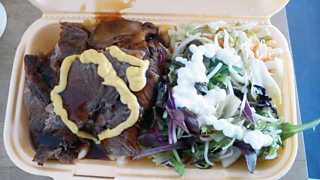How to avoid overcooking a food story: 10 tips for reporting nutritional science
Fiona Lethbridge
is senior press officer for the Science Media Centre
This post was co-written with Fiona Fox of the Science Media Centre.
In a previous blog we looked at some of the pitfalls in reporting food science in the light of some recent media fiascos.
On a positive note, for journalists looking for handy hints for reporting food science, here are some guidelines drawn up by the Science Media Centre and a group of science journalists.

Delicious BBC canteen lunch
Our top 10 tips:
- State the source of the story - e.g. interview, conference, journal article, a survey from a charity or trade body etc, ideally with enough information for readers to look it up or a web link
- Specify the size and nature of the study - e.g. who/what were the subjects, how long did it last, what was tested, or was it an observation? If space, mention the major limitations
- When reporting a link between two things, indicate whether or not there is evidence that one causes the other
- Give a sense of the stage of the research - e.g. cells in a laboratory or trials in humans - and a realistic timeframe for any new treatment or technology
- On health risks, include the absolute risk whenever it is available in the press release or the research paper - i.e. if ‘cupcakes double cancer risk’ state the outright risk of that cancer, with and without cupcakes
- Especially on a story with public health implications, try to frame a new finding in the context of other evidence - e.g. does it reinforce or conflict with previous studies? If it attracts serious scientific concerns, they should not be ignored
- If there’s space, quote both the researchers themselves and external sources with appropriate expertise. Be wary of scientists and press releases over-claiming for studies
- Distinguish between findings and interpretation or extrapolation; don’t suggest health advice if none has been offered
- Remember the public: reading in the newspaper that something is ‘good for you’ or ‘bad for you’ can lead to behavioural change - make sure it’s evidence-based!
- Headlines should not mislead the reader about a story’s contents and quotation marks should not be used to dress up overstatement.
There's more about reporting in the Academy website's section on journalism skills.
